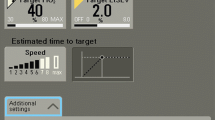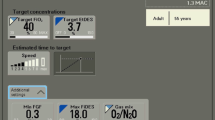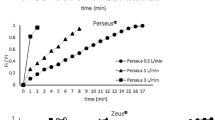Abstract
Purpose
New-generation anesthesia machines administer inhalation anesthetics and automatically control the fresh gas flow (FGF) rate. This study compared the administration of minimal flow anesthesia (MFA) using the automatically controlled anesthesia (ACA) module of the Mindray A9 (Shenzhen, China) anesthesia machine versus manual control by an anesthesiologist.
Methods
We randomly divided 76 patients undergoing gynecological surgery into an ACA group (Group ACA) and a manually controlled anesthesia group (Group MCA). In Group MCA, induction was performed with a mixture of 40–60% O2 and air with a 4 L/min FGF until the minimum alveolar concentration (MAC) reached 1. Next, MFA was initiated with 0.5 L/min FGF. The target fraction of inspired oxygen (FiO2) value was 35–40%. In Group ACA, the MAC was defined as 1, and the FiO2 was adjusted to 35%. Depth of anesthesia, anesthetic agent (AA) consumption, time to achieve target end-tidal AA concentration, awakening times, and number of ventilator adjustments were analyzed.
Results
The two groups showed no statistically significant differences in depth of anesthesia or AA consumption (Group ACA: 19.1 ± 4.9 ml; Group MCA: 17.2 ± 4.5; p-value = 0.076). The ACA mode achieved the MAC target of 1 significantly faster (Group ACA: 218 ± 51 s; Group MCA: 314 ± 169 s). The number of vaporizer adjustments was 15 in the ACA group and 217 in the MCA group.
Conclusion
The ACA mode was more advantageous than the MCA mode, reaching target AA concentrations faster and requiring fewer adjustments to achieve a constant depth of anesthesia.


Similar content being viewed by others
Data availability
Not applicable.
References
Baum JA, Aitkenhead AR. Low-flow anaesthesia. Anaesthesia. 1995;(50 Suppl):37–44. https://doi.org/10.1111/j.1365-2044.1995.tb06189.x.
Baum JA, Nunn G. Low flow anaesthesia: the theory and practice of low flow, minimal flow and closed system anaesthesia. 2nd ed. Boston: Butterworth-Heinemann; 2001.
Simionescu R. Safety of low flow anaesthesia. Circular. 1986;3:7–9.
Lucangelo U, Garufi G, Marras E, Ferluga M, Turchet F, Bernabè F, Comuzzi L, Berlot G, Zin WA. End-tidal versus manually-controlled low-flow anaesthesia. J Clin Monit Comput. 2014;28(2):117–21. https://doi.org/10.1007/s10877-013-9516-8.
Nunn G. Low-flow anaesthesia. Continuing Education in Anaesthesia. Crit Care Pain. 2008;8(1):1–4. https://doi.org/10.1093/bjaceaccp/mkm052.
Buhre W, De Robertis E, Gonzalez-Pizarro P. The Glasgow declaration on sustainability in Anaesthesiology and Intensive Care. Eur J Anaesthesiol. July 2023;40(7):461–4. https://doi.org/10.1097/EJA.0000000000001862.
Patil VP, Shetmahajan MG, Divatia JV. The modern integrated anaesthesia workstation. Indian J Anaesth. 2013;57(5):446–54. https://doi.org/10.4103/0019-5049.120139.
Sieber TJ, Frei CW, Derighetti M, Feigenwinter P, Leibundgut D, Zbinden AM. Model-based automatic feedback control versus human control of end-tidal isoflurane concentration using low-flow anaesthesia. Br J Anaesth. 2000;85(6):818–25. https://doi.org/10.1093/bja/85.6.818.
Arora K, Swami A, Puppala P, Rai A. Comparative study of automated end tidal control versus manual fresh gas flow adjustment with respect to gas usage and delivery during low flow anesthesia. Anesth Crit Care. 2020;2(2):39–51.
Skalec T, Górecka-Dolny A, Zieliński S, Gibek M, Stróżecki Ł, Kübler A. Comparison of anaesthetic gas consumption and stability of anaesthesia using automatic and manual control over the course of anaesthesia. Anaesthesiol Intensive Ther. 2017;49(1):34–9. https://doi.org/10.5603/AIT.2017.0008.
Lortat-Jacob B, Billard V, Buschke W, Servin F. Assessing the clinical or pharmaco-economical benefit of target controlled desflurane delivery in surgical patients using the Zeus anaesthesia machine. Anaesthesia. 2009;64(11):1229–35. https://doi.org/10.1111/j.1365-2044.2009.06081.x.
Singaravelu S, Barclay P. Automated control of end-tidal inhalation anaesthetic concentration using the GE Aisys Carestation™. Br J Anaesth. 2013;110(4):561–6. https://doi.org/10.1093/bja/aes464.
Mostad D, Klepstad P, Follestad T, Pleym H. Desflurane consumption with automated vapour control systems in two different anaesthesia machines. A randomized controlled study. Acta Anaesthesiol Scand. 2021;65(7):895–901. https://doi.org/10.1111/aas.13825.
Tay S, Weinberg L, Peyton P, Story D, Briedis J. Financial and environmental costs of manual versus automated control of end-tidal gas concentrations. Anaesth Intensive care. 2013;41(1):95–101. https://doi.org/10.1177/0310057X1304100116.
De Cooman S, Lecain A, Sosnowski M, De Wolf AM, Hendrickx JF. Desflurane consumption with the Zeus during automated closed circuit versus low flow anesthesia. Acta Anaesthesiol Belg. 2009;60(1):35–7.
Yardımcı ZA. (2021) Düşük Akım Anestezı̇sı̇ Uygulanan Hastalarda End-Tı̇dal Kontrolün Manuel Kontrollü Teknı̇ğe Göre Klı̇nı̇k ve Sevofluran Kullanımının Farmakoekonomı̇k Etkı̇sı̇nı̇n Değerlendı̇rı̇lmesı̇. Dissertation, Gazı̇osmanpaşa University.
Wetz AJ, Mueller MM, Walliser K, Foest C, Wand S, Brandes IF, Waeschle RM, Bauer M. End-tidal control vs. manually controlled minimal-flow anesthesia: a prospective comparative trial. Acta Anaesthesiol Scand. 2017;61(10):1262–9. https://doi.org/10.1111/aas.12961.
Struys MM, Kalmar AF, De Baerdemaeker LE, Mortier EP, Rolly G, Manigel J, Buschke W. Time course of inhaled anaesthetic drug delivery using a new multifunctional closed-circuit anaesthesia ventilator. In vitro comparison with a classical anaesthesia machine. Br J Anaesth. 2005;94(3):306–17. https://doi.org/10.1093/bja/aei051.
Brattwall M, Warrén-Stomberg M, Hesselvik F, et al. Brief review: theory and practice of minimal fresh gas flow anesthesia. Can J Anesth/J Can Anesth. 2012;59:785–97. https://doi.org/10.1007/s12630-012-9736-2.
Kennedy RR. Seeing the wood for the trees: insights into reducing inhalational agent consumption. Acta Anaesthesiol Scand. 2021;65(7):861–2. https://doi.org/10.1111/aas.13926.
Kennedy RR, French RA. A ten-year audit of fresh gas flows in a New Zealand hospital: the influence of the introduction of automated agent delivery and comparisons with other hospitals. Anaesth Intensive care. 2014;42(1):65–72. https://doi.org/10.1177/0310057X1404200112.
Funding
This study was supported by Sakarya University Scientific Research Projects (BAP) Commission under project number 2022-7-25-62.
Author information
Authors and Affiliations
Contributions
K.H. conducted the statistical analysis of the data. P.O. applied power analysis with a sample patient group at the beginning of the study. Literature search was performed by R.Ş. T.T.A. reviewed and made revisions, outlining the main points of the study. All authors read and approved the final manuscript.
Corresponding author
Ethics declarations
Competing interests
The authors declare no competing interests.
Conflict of interest
The authors declare that they have no conflicts of interest related to the present work.
Ethical approval
This study was conducted in accordance with the ethical approval of the Sakarya University Faculty of Medicine Clinical Research Ethics Committee, dated February 7, 2022, with protocol number 102934.
Additional information
Publisher’s Note
Springer Nature remains neutral with regard to jurisdictional claims in published maps and institutional affiliations.
Rights and permissions
Springer Nature or its licensor (e.g. a society or other partner) holds exclusive rights to this article under a publishing agreement with the author(s) or other rightsholder(s); author self-archiving of the accepted manuscript version of this article is solely governed by the terms of such publishing agreement and applicable law.
About this article
Cite this article
Şerefoğlu, R., Kocayiğit, H., Palabıyık, O. et al. Comparison of automated and manual control methods in minimal flow anesthesia. J Clin Monit Comput (2024). https://doi.org/10.1007/s10877-024-01163-0
Received:
Accepted:
Published:
DOI: https://doi.org/10.1007/s10877-024-01163-0




